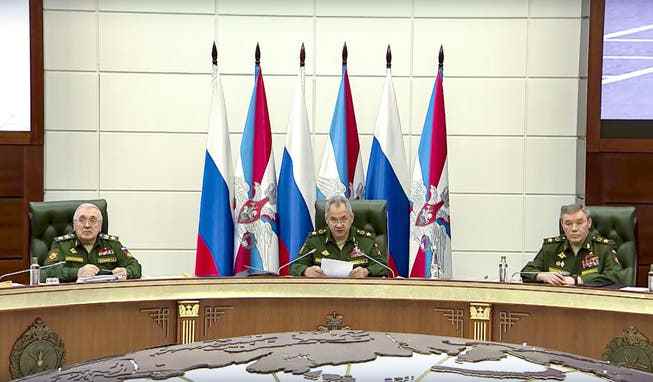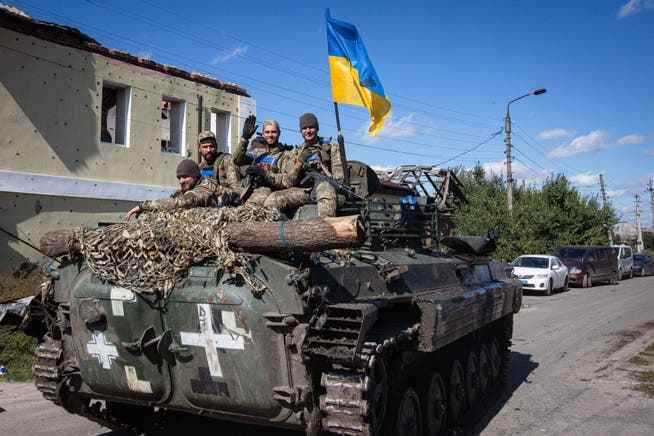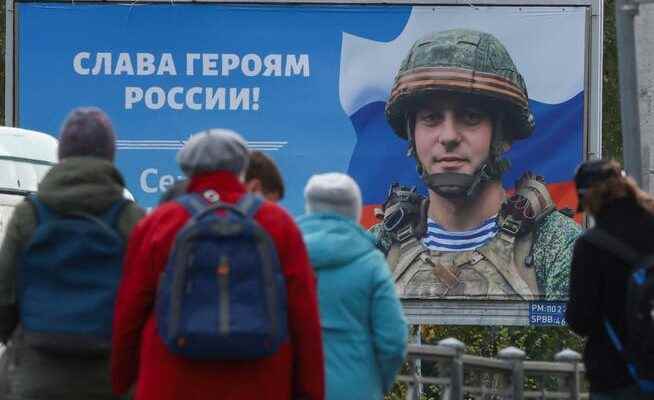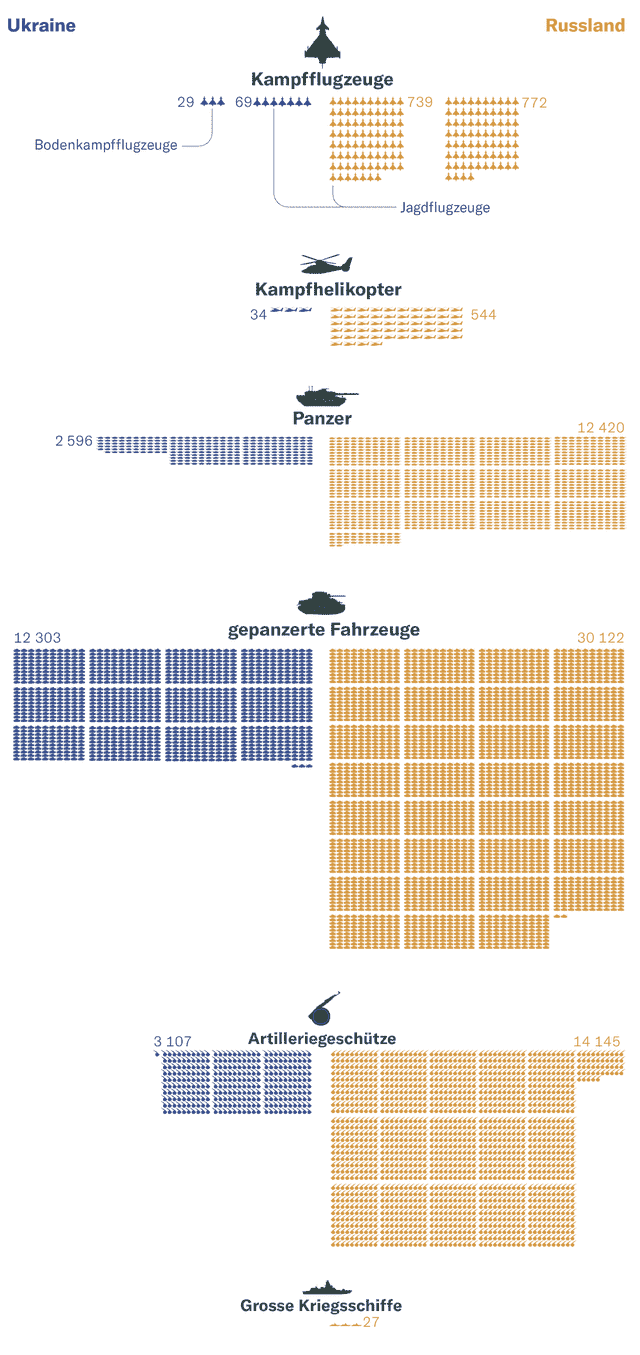Putin announces partial mobilization – but morale is likely to be low even among the reservists. Five questions and answers on the state of the Russian army.
People gather at a tram stop in front of a plaque with a portrait of a Russian soldier in Saint Petersburg.
In a televised speech on Wednesday morning, Russian President Vladimir Putin announced a partial mobilization of the Russian armed forces. 300,000 reservists who have already done military service and have a specialization and experience are to be called up.
Russian Defense Minister Sergei Shoigu justified the move by saying that Russia is now fighting the “collective West” or NATO because of Western support for Ukraine. Putin also spoke of the fact that the West had crossed borders with its “aggressive anti-Russian policy”.
With the mobilization, Russia’s combat power at the front should now be increased, where the Russian troops recently had to accept massive setbacks. But for Putin, this poses major political risks. The move is tantamount to an admission of failure.
Russia invaded Ukraine on February 24 with 160,000 to 180,000 men. Moscow’s primary goal was to capture the Ukrainian capital of Kyiv in the shortest possible time and to overthrow the government of Volodymyr Zelensky. This project clearly failed, and the advance on Kyiv was canceled at the end of March. Instead, Russia changed strategy and focused primarily on eastern Ukraine.
The fact that the staff is not sufficient even for this goal and that reservists have to be called up around seven months after the start of the war is testament to the colossal failure of Putin’s war plans in Ukraine. The decision to partially mobilize comes as a surprise in that it is politically risky for the Kremlin boss. Putin is thus admitting to his own people that the “special operation” is not going according to plan. At the same time, the reality of war has definitely arrived in Russian living rooms.

Russian Defense Minister Sergei Shoigu in a televised speech on September 21.
While it was primarily contract soldiers who had previously fought in Ukraine, including many members of ethnic minorities from eastern Russia, the partial mobilization of reservists now also affects middle-class families in Russia. Especially in the big cities of Moscow and St. Petersburg, the war seemed far away in the past few months. That should change now. Observers and experts are assuming that the unpopular decision will cause dissatisfaction with Putin’s policies to skyrocket.
According to official figures, the Russian army remains a formidable force. According to this, the army had previously had an upper limit of 1 million active military personnel and 900,000 civilian employees. There are also two million reservists. Western military experts, however, believe these numbers are inflated.
At the beginning, Putin promised not to use any recruits in combat operations. Instead, only contract soldiers, so-called “Kontraktniki”, would be eligible. As a rule, these are people who have done their basic military service and then entered into an employment contract with the army. So you already have some experience. However, in the course of the war, Russia also started raising recruits directly as “Kontractniki”.
While the original invading forces had been led to believe that “military special operations” were going on after four to five days completed, potential contract soldiers hardly harbor any such illusions. Morale suffers as a result. With the partial mobilization, however, the President makes it impossible for them to end the contract.

Ukrainian soldiers drive through the city of Izyum, recently liberated by Ukrainian forces.
Since early summer, the Kremlin has also been trying to expand the army by mobilizing volunteers more intensively and enforcing conscription more intensively. Even in prisons, prisoners should be recruited as soldiers. So far apparently with little success. So Putin not only lacks trained, but above all also lacks motivated Staff.
The partial mobilization now allows Putin to call on conscripts and reservists for war operations. Propagandists say that thanks to the 300,000 reservists, there is now an overweight against Ukraine.
On the other hand, there is probably little motivation. Because anyone who has a positive attitude towards the “special operation” and is willing to fight voluntarily in Ukraine has probably already reported for duty in just under seven months.
It is unclear whether the mobilization of the reservists would actually significantly improve the combat effectiveness of the army. The military expert Rob Lee points to the poor level of training of the reservists. Conscripts in Russia do not have to enlist regularly to refresh their military skills.
In addition, the Russian troops in Ukraine are already inadequately equipped. In the past few weeks and months, the Ukrainians have deliberately attacked supply lines, thereby decisively weakening Russian logistics capacities.
A look at the existing war material shows a fight between David and Goliath. Before the war, Western public opinion, even among many military experts, was therefore predicated on the assumption that Russia was vastly superior to Ukraine militarily.
But even with these advantages, Russia has not yet been able to achieve its goals in Ukraine. Reasons for this include misguided tactics, weaknesses in the command structure, in communication and in logistics, and heavy losses in war material. Using agile and creative tactics, the Ukrainians were able to inflict heavy casualties on the unwieldy Russian war machine.
In addition to mobilizing the reservists, Putin has also urged the armaments sector to increase the production of armaments of all kinds. Workers in this sector are also exempt from conscription for military service.
For the first time since March, Russian Defense Minister Sergei Shoigu has given a number of casualties on the Russian side. According to him, the number at that time was 5937. This information cannot be independently verified. External observers assume the number of victims to be much higher. So far, the heavy losses have caused little uproar in Russian society. But now it will no longer affect “Kontraktniki”, but reservists who may have been reluctant to be deployed. At best, the Kremlin will find it more difficult to justify their losses.
Losses on the Russian side are also considerable in terms of war material. According to estimate By May, more than a quarter of Russia’s 120 deployed tactical battalion groups were no longer fit for combat. The independent platform oryx, which documents the losses of Russian war equipment, has recorded more than 400 new entries since the start of the Ukrainian counter-offensive at the end of August alone. In total, since February 24, the Russian army has lost more than 6,000 tanks, army vehicles, aircraft and warships.
With the collaboration of Andreas Rüesch and Markus Ackeret.

